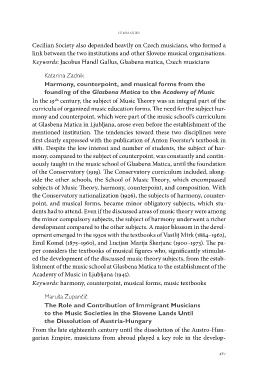Page 489 - Weiss, Jernej, ur./ed. 2023. Glasbena društva v dolgem 19. stoletju: med ljubiteljsko in profesionalno kulturo ▪︎ Music societies in the long 19th century: Between amateur and professional culture. Koper/Ljubljana: Založba Univerze na Primorskem in Festival Ljubljana. Studia musicologica Labacensia, 6
P. 489
summaries
Cecilian Society also depended heavily on Czech musicians, who formed a
link between the two institutions and other Slovene musical organisations.
Keywords: Jacobus Handl Gallus, Glasbena matica, Czech musicians
Katarina Zadnik
Harmony, counterpoint, and musical forms from the
founding of the Glasbena Matica to the Academy of Music
In the 19th century, the subject of Music Theory was an integral part of the
curricula of organized music education forms. The need for the subject har-
mony and counterpoint, which were part of the music school’s curriculum
at Glasbena Matica in Ljubljana, arose even before the establishment of the
mentioned institution. The tendencies toward these two disciplines were
first clearly expressed with the publication of Anton Foerster’s textbook in
1881. Despite the low interest and number of students, the subject of har-
mony, compared to the subject of counterpoint, was constantly and contin-
uously taught in the music school of Glasbena Matica, until the foundation
of the Conservatory (1919). The Conservatory curriculum included, along-
side the other schools, the School of Music Theory, which encompassed
subjects of Music Theory, harmony, counterpoint, and composition. With
the Conservatory nationalization (1926), the subjects of harmony, counter-
point, and musical forms, became minor obligatory subjects, which stu-
dents had to attend. Even if the discussed areas of music theory were among
the minor compulsory subjects, the subject of harmony underwent a richer
development compared to the other subjects. A major blossom in the devel-
opment emerged in the 1930s with the textbooks of Vasilij Mirk (1884–1962),
Emil Komel (1875–1960), and Lucijan Marija Škerjanc (1900–1973). The pa-
per considers the textbooks of musical figures who, significantly stimulat-
ed the development of the discussed music theory subjects, from the estab-
lishment of the music school at Glasbena Matica to the establishment of the
Academy of Music in Ljubljana (1945).
Keywords: harmony, counterpoint, musical forms, music textbooks
Maruša Zupančič
The Role and Contribution of Immigrant Musicians
to the Music Societies in the Slovene Lands Until
the Dissolution of Austria-Hungary
From the late eighteenth century until the dissolution of the Austro-Hun-
garian Empire, musicians from abroad played a key role in the develop-
487
Cecilian Society also depended heavily on Czech musicians, who formed a
link between the two institutions and other Slovene musical organisations.
Keywords: Jacobus Handl Gallus, Glasbena matica, Czech musicians
Katarina Zadnik
Harmony, counterpoint, and musical forms from the
founding of the Glasbena Matica to the Academy of Music
In the 19th century, the subject of Music Theory was an integral part of the
curricula of organized music education forms. The need for the subject har-
mony and counterpoint, which were part of the music school’s curriculum
at Glasbena Matica in Ljubljana, arose even before the establishment of the
mentioned institution. The tendencies toward these two disciplines were
first clearly expressed with the publication of Anton Foerster’s textbook in
1881. Despite the low interest and number of students, the subject of har-
mony, compared to the subject of counterpoint, was constantly and contin-
uously taught in the music school of Glasbena Matica, until the foundation
of the Conservatory (1919). The Conservatory curriculum included, along-
side the other schools, the School of Music Theory, which encompassed
subjects of Music Theory, harmony, counterpoint, and composition. With
the Conservatory nationalization (1926), the subjects of harmony, counter-
point, and musical forms, became minor obligatory subjects, which stu-
dents had to attend. Even if the discussed areas of music theory were among
the minor compulsory subjects, the subject of harmony underwent a richer
development compared to the other subjects. A major blossom in the devel-
opment emerged in the 1930s with the textbooks of Vasilij Mirk (1884–1962),
Emil Komel (1875–1960), and Lucijan Marija Škerjanc (1900–1973). The pa-
per considers the textbooks of musical figures who, significantly stimulat-
ed the development of the discussed music theory subjects, from the estab-
lishment of the music school at Glasbena Matica to the establishment of the
Academy of Music in Ljubljana (1945).
Keywords: harmony, counterpoint, musical forms, music textbooks
Maruša Zupančič
The Role and Contribution of Immigrant Musicians
to the Music Societies in the Slovene Lands Until
the Dissolution of Austria-Hungary
From the late eighteenth century until the dissolution of the Austro-Hun-
garian Empire, musicians from abroad played a key role in the develop-
487


